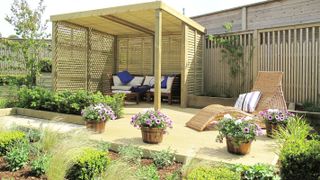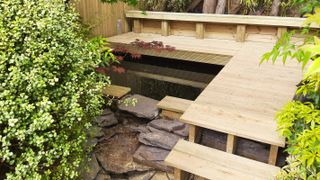Common decking mistakes and how to avoid them
Don't let needless decking mistakes ruin your garden — read our guide to the most common reasons for decking going wrong to ensure you get nothing but enjoyment from your new outdoor feature

Knowing what the most frequently-made decking mistakes are will help to ensure that your new garden seating area delivers everything you hoped it would and more.
Beautiful decking ideas can really bring another element to gardens of all shapes, sizes and styles. However, while installing decking is a job commonly successfully undertaken on a DIY basis, there are certain pitfalls it pays to be aware of if you want to dodge decking disaster.
There are several reasons why decking ends up going wrong, either during the laying process or a few weeks, months or years down the line — and we are here to reveal what they are. We asked the experts what errors they most often see being made in order that you can approach the task of choosing and fitting your new decking feeling confident that nothing will go awry.
What tops the list of decking mistakes?
Before getting into anything to do with installation, it is important to realise that however well you lay your decking and however much care you have taken in its design, there is one element that could spell disaster before the project even gets underway if you mess it up — the decking you buy. A poor quality product or one that is not well-suited for what you intend on using your deck for, bought purely because of its low price tag, is always going to be a false economy.
"If you’re looking for a deck that’s going to last for an extended period of time, then it’s advisable to use good quality hardwood or opt for composite decking instead of softwood," say the experts at Garden Buildings Direct. "Hardwood and composite decking not only last a lot longer but they look great and are less likely to become a safety hazard."
In terms of decking costs, wood decking is typically cheaper than composite decking. At the lower end, wood decking products made from a softwood such as pine will cost you around £10m/2, while prices for composite decking start at around £20-30m/2.
You can expect to pay up to four times the cost of a cheaper softwood for high quality hardwoods and composite.
Once you feel confident that you have chosen the best type of decking within your budget, ensure you get the most out of it by being wary of making the following mistakes.
1. Laying decking the wrong way up
When it comes to how to lay decking, the side of the decking that ends up facing out really can have an effect on how well the space is going to work for you.
"Despite the common belief that you should lay deck boards with the groove side up, it’s actually more effective to have the smooth side on display," say the experts at Garden Buildings Direct.
"This is because the grooves encourage air circulation beneath the deck which stops it from rotting. There’s no real extra grip achieved through having the ridges up and they can increase the difficulty of cleaning a wooden deck.
"These grooves might only help with water runoff if built on an angle, so if you want your decking to last a long time it’s best to have the smooth side facing upwards.”
2. Building a deck that is too small
This might sound obvious, but getting the size of your deck right is absolutely key — not only with regards to your enjoyment of the feature, but also in how well it sits alongside the rest of your garden design.
"Make sure you carefully plan how much of your garden you want to cover with decking," say Garden Buildings Direct. "Too little and you won’t have enough space to fit furniture and planters on. But too much and you can lose the natural feel of the garden — leaving no space for wildlife to flourish."
While there is no 'golden ratio' to adhere to, it makes sense to grab your measuring tape and and work out how much space you are going to need for all the items you want to place on your new deck — table, chairs, sun loungers, plants and so on. If you plan on fitting lights into your deck, or a pergola over, don't forget to factor in the space needed for these too.
Finally, remember you will need circulation space on the deck — there is no point in having a dining table and chairs if you don't have the room to walk around them or pull out a chair to sit down.

3. Failing to take movement into account
Just as when laying a wooden floor, when it comes to fitting a deck, you need to bear in mind that a degree of movement needs to be expected.
"As wood is a natural material it will expand and contract under different conditions," explain the experts from Garden Buildings Direct. "In humid conditions decking tends to expand due to the increase in water in the air, and when the moisture is drawn out this is when decking can contract.
"Composite decking won’t change form as much as real wood. However, it can change size depending on whether it’s hot or cold. This is why it’s important to leave a gap between the boards, as it gives your deck adequate space to change without damaging the integrity of the entire structure."
Aim to leave an expansion gap of 5-8mm between each board and make sure the gap is even along the length.

4. Leaving space for unwanted deck guests
Don't turn your deck into a hotel for garden creatures by leaving space for them to get beneath.
"Underneath the deck can become a rat’s new home if you don’t make sure there aren’t any gaps for them to crawl into," say Garden Buildings Direct. "You can do this by filling in the frame of the deck with hardcore, soil or any other available material. If you want to be extra cautious, you can put chicken wire or mesh around the edge of the decking, although this may affect the overall aesthetic."
5. Laying boards in the wrong direction
The direction in which you lay your board can have a huge effect on its final appearance as well as how well it works on a practical level.
"Which way should you orient your decking boards in your scheme? In general, think of them like floorboards, and choose the direction that best flatters the proportions of your garden," says Homebuilding & Renovating's Assistant Editor Amy Reeves. "Decking boards tend to be run horizontally, mirroring the lines of the house and patio doors, but vertical lines will help draw the eye out into the garden."
"Install decking boards in the opposite way to the direction of travel," advises Leigh Barnes at Jacksons Fencing. "This will increase the slip resistance and give you more grip."
6. Failing to seal the deck after installation
Choosing the right materials and installing the deck properly is just the beginning of ensuring your deck is a success — how you finish the whole thing off is also hugely important, particularly if you have opted for timber decking as opposed to composite.
"Not sealing the deck straight away can lead to the wood weathering quickly, thus rapidly decreasing the lifespan of your deck," suggest the experts at Garden Buildings Direct. "Newly installed wood is in the best condition to be coated and sealant is easy to come by, it can be found in most DIY or hardware stores." Try No Nonsense Decking Sealer & Protector Clear from Amazon.
Many of the best decking paints will also offer protection, slip resistance and a pop of colour.

7. Buying poor quality screws
Your deck is only ever going to be as good as the materials you choose to hold it together — and your choice of screws and nails are really important here.
"Don’t forget about the screws!" says Leigh Barnes of Jackson Fencing. "Nails and screws are essential to any decking installation, and they should, at the very minimum, be galvanised or stainless steel. Anything less, and within a few months of rain, there will be rust marks all over your brand new decking."
Obviously the length of your screws will need to be chosen once you know the type of boards you are using — but be sure to buy decking screws.
8. Scrimping on the foundations
A well-built base is the secret to a deck that will stand the test of time. "A solid foundation is crucial to a successful deck," begins Leigh Barnes. "Using timber posts and joist that are suitably treated for life in the ground will ensure your decking will last.
"Even if you are using alternative materials to timber for the decking boards, we always recommend timber posts and joists for the frame as it has been tried and tested over the years as the best and strongest material to support decking. Timber is also a flexible and adaptable material which is not brittle and will not break, which is important for safety reasons."
When it comes to how to build a raised deck, the foundations are more important than ever and once again, much of the success of this kind of project rests on your choice of materials.
"The material you choose must be strong enough to take the weight of a raised deck, so pressure-treated wood or resistant softwoods, or composite lumber and metal framing are excellent options," says Allan Jeffrey, Managing Director at Ultra Decking.

9. Not checking a product's guarantee
Deciding on the right material for your decking can be hard, particularly when it comes to the choice between wood decking vs composite. However, whichever you end up opting for, be sure to only buy a product that comes with a long guarantee.
"Choose a product that will last," says Leigh Barnes "Decking is a permanent feature, and if it doesn’t look the part or has been poorly installed, it’ll throw your whole garden renovation off.
"Ensure it’s been supplied with a long guarantee to avoid rot and insect attack — both of which could cause your decking to fail a few years down the line. Timber must be treated correctly for use outside and in the ground.
"If a manufacturer isn’t confident enough in their products to offer a guarantee, it’s highly likely they won’t last long, and you won’t be covered for any replacements."
10. Ignoring the deck's maintenance requirements
And the final decking mistake most commonly seen by the experts? Bad maintenance.
There is no point in going to all the trouble and expense of installing a new deck only to find it is rotting, covered in slippery moss growth or discoloured a few months in.
"You should periodically clean any moss or lichen off the surface of the decking to prevent it from becoming hazardous," says Leigh Barnes.
If you are wondering how to clean decking, providing you keep on top of the job you might find that all that is needed is a quick wash down with soapy water. However, after a winter of disuse, you might need a little more in the way of elbow grease and specialist deck cleaning products. You could try a product such as Cuprinol Decking Cleaner from Amazon, but if you need something a little stronger, you might need to turn to a decking stripper.
Something like Ronseal Decking Stripper from B&Q is great if you want to give your deck a complete overhaul but be aware that it doesn't just take away dirt — any coatings, oils and stains will also be stripped away so you will be starting from scratch.
Get the Homebuilding & Renovating Newsletter
Bring your dream home to life with expert advice, how to guides and design inspiration. Sign up for our newsletter and get two free tickets to a Homebuilding & Renovating Show near you.
Natasha is Homebuilding & Renovating’s Associate Content Editor and has been a member of the team for over two decades. An experienced journalist and renovation expert, she has written for a number of homes titles. Over the years Natasha has renovated and carried out a side extension to a Victorian terrace. She is currently living in the rural Edwardian cottage she renovated and extended on a largely DIY basis, living on site for the duration of the project. She is now looking for her next project — something which is proving far harder than she thought it would be.
